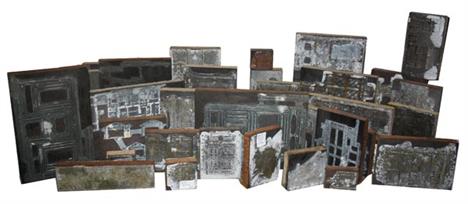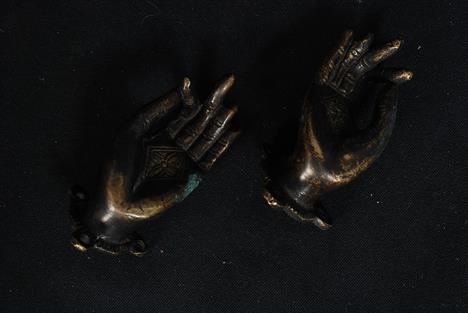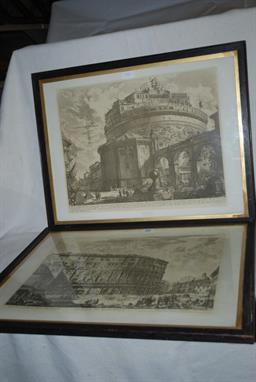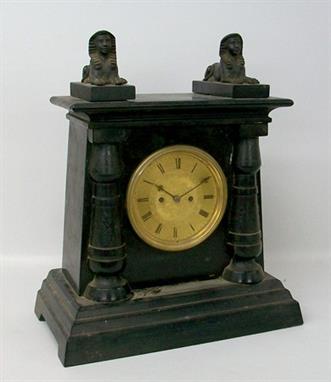We found 35023 price guide item(s) matching your search
There are 35023 lots that match your search criteria. Subscribe now to get instant access to the full price guide service.
Click here to subscribe- List
- Grid
-
35023 item(s)/page
A set of four Victorian stone composition architectural corbels, late 19th century, by Joseph Cliff and Sons, Wortley, Leeds, each with a rising acanthus cast volute, 40cm high, 19cm wide, 27cm deep. Provenance: Removed from a gas works, Old Kent Rd, London. Joseph Cliff (1806-1879) was the founder of a brick works at Wortley, also owning the Micklefield Colliery near Leeds with his four sons. Cliff typified the dynamic Victorian industrialist with interests in many inter-related areas of industry including ironstone mining and coke production. Cliff also built the furnaces of the Frodingham Iron Company, producing iron from May 1865 and of course charging them with coke from his own facility at Penistone.
A set of four Victorian stone composition architectural corbels, late 19th century, by Joseph Cliff and Sons, Wortley, Leeds, each with a rising acanthus cast volute, 40cm high, 19cm wide, 27cm deep. Provenance: Removed from a gas works, Old Kent Rd, London. See lot 397 for notes on Joseph Cliff.
A Charles II carved oak gate top rail, circa 1669-72, from one of the two gates of Sir Christopher Wren’s Temple Bar, London, of serpentine form, one end with a scrolled volute issuing foliage and a profusion of fruit and further flowers, above a moulded edge to one side, the corresponding serpentine lower edge with further mouldings, bearing a brass plaque inscribed ‘TOP OF THE GATES OF ‘TEMPLE BAR’ DESIGNED BY WREN AFTER THE FIRE OF LONDON IN 1666. IT WAS TAKEN DOWN BY JOHN MOWLEM & CO UNDER THE SUPERINTENDENCE OF G.B. IN 1877 THE YEAR BEFORE HE WAS SHERIFF OF LONDON 7 MIDDLESEX’, 69cm high, 265cm long, 23cm wide. Temple Bar, the principle western gateway into The City of London from The City of Westminster, is named after the Temple Church near which it stood. Originally a defensive boundary as well as an administrative one, its most important function became ceremonial. It was here on Fleet Street that the coronation processions of British monarchs halted, and where the Lord Mayor confirmed London’s civic loyalty. He would hand over the City’s Sword of State as he threw open the gates and granted the monarch access to The City. Temple Bar was thus an important London landmark. It was the last of the City gates to survive into the 19th century. From about 1840, however, it was increasingly criticised both as a barrier to the ever-growing flux of London traffic, and as an outdated relic in a parish which was being rebuilt and modernised in accordance with prevailing architectural fashions.Thus in 1877 it was resolved that it should be demolished to allow for the widening of Fleet Street and to enable work on the Royal Courts of Justice, the dismantling beginning in January the following year and taking just eleven days. Ultimately the Bar was bought by Lady Meux and removed to Theobald’s Park at Cheshunt, Hetfordshire where it remained until 2004, when it was repurchased by the Temple Bar Trust and re-erected in Paternoster Square near St Paul’s Cathedral. Built between 1669 and 1672 by Joshua Marshall [Master Mason to King Charles II from 1673] and Thomas Knight [Mason to the City] of Portland Stone along English Baroque principles, each of the gate’s facades has four Corinthian pilasters, an entablature and an arched pediment. Four niches house statues of Charles I, Charles II, James I and his queen, Anne of Denmark. Scrolls flank the upper part of the Bar and the pediments were once adorned with carved fruit and flowers. These swags mirror those of the timber gate cresting. Beneath this superstructure, two narrow posterns for foot traffic stood either side of a 21-foot wide central arch to accommodate vehicles. This central arch was hung with a pair of oak gates, and it is one of these that the cresting is from. Little information relating to its rebuilding survive in Wren’s papers. Visual representations of the Bar (mostly 19th century engravings and prints) invariably show it with the timber gates open so that their decoration is not visible. Photographs of the Bar standing at Theobalds Park do show gates of four rows of eight panels with a moulded toprail that is slightly arched or raised. These gates, now restored and re-instated in Paternoster Square are the original gates and of a shape and format that could indeed have supported the ornate carving together with its pair. The unknown fate of the pair to the LASSCO cresting is likely to have determined the removal of both. There are compelling reasons that all but confirm that the cresting is indeed the original piece adorning the gates to Wren’s 1672 gateway. Most importantly, a medal struck from the lead roof of the Bar in 1878 and commissioned to commemorate its demolition, depicts the gates with a scrolling festoon-carved cresting exactly of the design of the oak carving. The fruit-carved crestings echo the stone carvings of fruit and flowers which are known to have adorned the top part of the Bar, and so it is in stylistic keeping with the design of the rest of the structure. The details given by the plaque affixed to the cresting are correct and the man that they name (by initials only) is known to have kept pieces of other buildings that his firm demolished. John Mowlem & Co, a masonry company founded in 1822, was the firm contracted to build the commemorative column which replaced the Bar and which was erected in 1880 George Burt, the ‘GB’ mentioned in the plaque on the gate cresting (nephew to John Mowlem and director of the company at the time of the Bar’s removal), was a collector of relics of old London, often from his firm’s own demolitions, many of which including the porch removed from the Mercers’ Hall, were re-erected in his native Swanage (see Greater London Industrial Archaeology Society, August 2007). This predilection, and the fact that the plaque on the cresting records the date of its removal as 1877, suggests that George Burt removed it at the end of that year, shortly before work began on the Bar’s demolition on January 2nd 1878. As Sheriff of London and Middlesex in the following year, and thus one of London’s leading dignitaries, it is probable that he felt compelled to salvage part of Temple Bar, one of London’s most important civic sites.
A 19th century embossed leather covered table top cabinet in the classical architectural style, the top opening to reveal a needlework compartment over two cabinet doors enclosing three drawers, one fitted for jewellery, over a lower drawer with writing slope CONDITION REPORTS Height approx 43cm max, width approx 36cm. Exterior with dirt, fading, some tears and losses. Top section has separated. Hinged top compartment has wear and some losses to interior. Interior drawer section has some damage and losses, including one drawer missing. Contents of various sewing accoutrements in the hinged top compartment. Some decorative fitments missing. Wear to gilding. There is also a writing slope section to the base, slopes themselves appear in reasonably good condition. Compartment underneath the slope contains various vintage stationery items. Overall in need of some restoration.
A 19th century American walnut cased eight day mantel clock of architectural form, the movement by Seth Thomas of Connecticut CONDITION REPORTS Wear, dirt and scuffs. Some chips and dents to enamelled dial. Some staining. Applied decorative wood sections to base appear slightly crooked - may have been reglued.
AFTER GEORGE ROMNEY "Lady Hamilton as Nature", black and white etching by M Paulier, bears Leggatt Brothers label verso, AFTER DUBOURG "Arrival at Brandenburgh House of the Watermen and with an address to The Queen on 3rd October 1820", coloured engraving, AFTER A SHAMET - a set of four coloured artist's proof prints, EARLY 20TH CENTURY CONTINENTAL SCHOOL "A group of four ballet dancers", black and white print, EARLY 20TH CENTURY CONTINENTAL SCHOOL "Study of a reclining nude", coloured print and AFTER CHARLES BIRD - a set of six black and white architectural engravings, signed in pencil in the margin, bearing original titled plate label verso
Alexandre DUMAS et F. GAILLARDET. La Tour de Nesle. Paris, Imprimé pour les Amis des livres, 1901. In-4, maroquin marron, plaque incisée sur chaque plat avec, d`une part, La Tour de Nesle dans un encadrement quadrilobé avec feuilles de houx et têtes de monstres et, d`autre part, une femme en buste masquée dans un encadrement architectural trilobé avec également feuilles de houx et têtes de monstres, dos à 5 nerfs se prolongeant sur les plats, encadrement intérieur avec filets et fleurons dorés, doublure et gardes de soie olive, doubles gardes, tranches dorées sur témoins, couverture et dos, chemise demi-maroquin à recouvrement, étui (Aussourd)., Première édition illustrée de ce Drame en cinq actes et neuf tableaux représenté pour la première fois à Paris, sur le Théâtre de la porte Saint-Martin, le 29 mai 1832., Une vignette de titre en un ton et 34 illustrations en couleurs de Albert Robida gravées sur cuivre par Beltrand, dont 9 hors-texte et 5 portraits., Tirage limité à 115 exemplaires sur papier du Marais, celui-ci imprimé pour le marquis de Salvert-Bellenave., Très bel exemplaire superbement relié par Aussourd avec des plats incisés inspirés des illustrations de Robida., De la bibliothèque Lucien Gougy (III - 19, 20 et 21 novembre 1934, n°287).
Pair of Gilt Lacquer Dragon Architectural Fragments, 19th Century Contained within a quatrefoil shape border and framed with a continuous Greek key-fret border, the scene carved in high relief with a pair of dragons, one larger and the smaller with a flaming pearl, the two mythical beasts surrounded by scrolling clouds, 12.4" x 19.7" — 31.5 x 50 cm. Provenance: Chinese Porcelain from a Hong Kong Collector (lots 216-222) Purchased from auctions and dealers in Hong Kong during the late 1970’s and throughout the 1980’s. Starting Price: $2000
Lee Stone Art Deco architectural drawings Lee Stone Art Deco architectural drawings, two, by Lee Stone Designs, table designs in colored pencil on paper, framed size: 16" x 12", excellent original condition The paper has yellowed. There is a small pin hole at each corner of the drawings. Inexpensive IKEA frames. Starting Price: $150
Habitat coffee table Habitat coffee table, thick glass top supported by an aluminum cylinder with a counterweight, original finish, signed with "Habitat Architectural Supplements" label, 48"w x 22"d x 15"h, very good original condition Chip to the glass. Light to moderate surface scratches, scuffs, and abrasions. Sturdy and structurally sound. Scuffs to the aluminum base. Starting Price: $200
Architectural Forum magazine architects Frank Lloyd Wright The Architectural Forum January 1938, the magazine for architects, this issue was devoted to the work of Frank Lloyd Wright, very good condition Please contact the John Toomey Gallery to request a condition report on this lot: info@johntoomeygallery.com or (708) 383-5234. The absence of a condition report does not imply that the lot is in perfect condition. Starting Price: $150
A GILT METAL MOUNTED MAHOGANY BRACKET CLOCK IN 18th CENTURY STYLE, circa 1920, the architectural case with arched pediment, lion mask handles and paw feet, enclosing a brass dial with silvered chapter ring signed Fattorini & Bros, Bradford, German eight day movement quater striking on a gong. Height 40cm
1902 5% Gold Loan `Cheng-Ting Railway Loan`, bond for 500 francs, Paris 1903, no.04151 and coupon receipt no.6487, large format, ornate border incorporating dragons and architectural designs, brown and black, green underprint no couopons, centrefold and small nicks along right hand border otherwise very fine (2) Vat Status: Margin Scheme View Terms & Conditions
Banque Industrielle de Chine, a group of 10 certificates for 500 frans share, third issue, 1920, cityscape at bottom flanked by Chinese dogs, architectural border with dragons at top, yellow and black, with full coupon sheets, generally extremely fine and better. (10) Vat Status: Margin Scheme View Terms & Conditions
Vilhelm LAURITZEN (1894-1984) & FRITZ HANSEN (Éditeur) Tabouret circulaire, 1940, réalisé en très peu d`exemplaires pour la Maison de la Radio de Copenhague, piétement quadripode en hêtre formant deux arcatures légèrement méplates, à montage tenons-mortaises au niveau des courbures, réunies par une entretoise circulaire et soutenant l`assise en suspension recouverte de cuir cognac patiné. A stool designed in a very limited quantity for the Radio house in Copenhagen, beech and patinated cognac leather, floating seat construction. Haut. 46,3 cm - Diam. 45 cm / Height. 18 1/4 in. - Diam. 17 3/4 in. Historique : Vilhelm Lauritzen fut un des architectes les plus influents des années 30 et 40, fondateur de la firme Vilhelm Lauritzen Arkitekter toujours en activité. A la fin des années 30, ses techniques et structures innovantes le rendent très proche du mouvement fonctionnaliste, c`est sur cette base stylistique qu`il conçut un modernisme retenu qui fût la base de son oeuvre à partir des années 30 et grâce auquel il fut reconnu. Il fut également le premier employeur de Finn Juhl. The architect Lauritzen was one of the most influential designers of the 1930/40`s, founder of the still active architectural firm Vilhelm Lauritzen Arkitekter. At the end of the 30`s, he became acquainted with the latest trends in Functionalist architecture with its technical and structural innovations. This inspired him to a grounded and restrained Modernism and it was with such buildings that he had his breakthrough. He was also the first employer of Finn Juhl.
CHEKHONIN, SERGEI(1878-1936)Design for a Niche with a Statue of the Virgin Mary, signed and inscribed "Paris".Pencil, watercolour and gouache on paper, 33 by 25 cm. Fine art connoisseurs very often associate Sergei Chekhonin with Soviet agitprop porcelain. Chekhonin, however – as well as being a revolutionary pioneer in the field of industrial design (he was artistic director from 1918 to 1927 at the Petrograd, later Leningrad, State Porcelain Factory) – was primarily a consummate book designer. In the 1910s he proved to be one of the masters whose work established the high standard of Russian graphic art. With his impeccable grasp of lettering and ornamentation Chekhonin, in conjunction with Dmitri Mitrokhin and Georgiy Narbut, belonged to the younger generation of members of the World of Art group who raised graphic art in books to a new level. His exquisite pen and watercolour drawings became absolute Russian classics of the first quarter of the 20th century. The well-known Russian art historian Abram Efros called Chekhonin’s style “Soviet Empire”. The work in this catalogue is most probably a sketch for the decoration of an architectural niche. The artist produced it in Paris at the very end of the 1920s or beginning of the 1930s."
VIENNA PORCELAIN PLATE, HAND PAINTED WITH A YOUNG WOMAN LIGHTING A CANDLE LANTERN, with a richly gilt architectural and foliate scroll border, on a midnight blue ground, signed F. Wagner diameter, 9½" (24cm) diameter, INSCRIBED VERSO "MÄDCHEN MIT DER LANTERNE" AFTER GERARD DOU 1613-1675, K. K. GEMALDE GALLERIE, WIEN, red bee hive mark
Winkles`s Architectural and Picturesque Illustrations of the Cathedral Churches of England and Wales. London: Bogue, 1851. Three octavo volumes, profusely illustrated, bound in three-quarter red morocco and marbled paper by S. Kaufmann, edges stained yellow, contents with minor spotting, 10 1/4 x 6 3/4 in. (3).
A Victorian Mahogany cased Vienna Wall Clock having architectural pediment top with finials and ladies head motif, single arch pane glazed door flanked by half turned columns, lower pediment and mouldings, finials, etc. enamel and brass 24 hour face, eight day movement, marked GB to the face, ornate brass pediment. 36'' high x 16'' wide x 7 1/8'' deep
A Victorian Mahogany and stained Pine cased Vienna Wall Clock having architectural single arch with lion mask and finials, single arch pane glazed door flanked by half turned columns, lower mouldings and finials, enamel and brass Roman numerals, the face stamped with 'J' in a star, eight day movement and brass pediment. 35'' high x 15'' wide x 6 1/2'' deep.
A Victorian slate mantel clock, the architectural case surmounted with a pair of sphinx, the engraved brass dial with black Roman numerals, marked James Murray & Co, Royal Exchange, London, no 1255, eight day movement, hour striking on a bell, 33 by 18 by 39cm. Provenance: The Estate of David Powell MBE.
An early 19th century figured mahogany cased long case clock of architectural form in the French Empire taste, the pointed arched hood with glazed door over a panelled trunk door flanked by stop fluted and gilt metal mounted pilasters to a flat fronted base, the square brass dial with Roman numerals, strike/silent subsidiary seconds dial inscribed "Barwise, London" with eight day striking movement, 193 cm high CONDITION REPORTS BRASS DIAL WITH SURFACE SCRATCHES AND BLACK LINE MARKINGS - SEE PHOTOS. CASE - HOOD WITH 3 INCH LOSS TO FLUTED FRIEZE. MOULDING LEFT AND RIGHT MISSING. PILASTERS FLANKING DOOR WITH WORM HOLES. BASE WITH MOULDING MISSING FRONT, LEFT AND RIGHT. ALSO VENEER LOSS TO SCROLL PILASTERS. REPLACEMENT AND LATER PAINTED MOVEMENT REST. BLOCK ATTACHED TO BACK. TIP OF WOODEN SHAFT TO PENDULUM BROKEN - SEE PHOTOS. Case overall in need of restoration.
Paul Henry RHA (1876-1958) FIGURES IN THE WOODS, c.1903pencil and charcoal with ink on papersigned lower left; also inscribed in the artist`s hand, Paul Henry White Cottage Knaphill Surrey` on the reverseP15.75 by 11in., 39.375 by 27.5cm.Adam`s, 7 April 1993, lot 106;Private collectionKennedy, S.B., Paul Henry, Paintings Drawings Illustrations, Yale University Press, New Haven & London, 2007, catalogue no. 259, p.144 (listed)Dated c.1903 on the evidence of the signature, its scroll-like surround and the architectural structure at the base of the drawing. It resembles another Henry piece, The wedding was the greatest affair that was ever seen in France, 1902-3 (Kennedy, 2007, catalogue no. 6) The latter, and Figures in the Woods, were almost certainly part of a number of drawings made to illustrate an unknown narrative. As Henry moved into White Cottage, Knaphill, in 1903 this drawing cannot date before that year.The strongest Whistlerian nature of the drawing is typical of Paul Henry`s illustrative work done in the years before he first went to Achill. Charcoal was almost his sole medium in those years. `No chalk or crayon has the same soft, velvety quality, no other material is so sensitive and tractable,` he later wrote. `I felt every time I used it, that the vine branches from which it was made brought me nearer to the spirit of France in some almost mystical way.` In An Irish Portrait **INSERT FOOTNOTE**1. he stated that his love of charcoal dated from a chance encounter with a charcoal burner at Rambouillet in 1900, but in fact he was using it long before that meeting, which may merely have confirmed its qualities to him. Indeed, it is more likely that it was a group of drawings by Millet, done in charcoal and sanguine and executed with spontaneity, as Millet`s finished pictures were not, which started him using the medium.Dr S.B. KennedyFootnote:1. Paul Henry, An Irish Portrait, Batsford, London, 1951, p.29See An Irish Portrait, p.24
-
35023 item(s)/page
























































